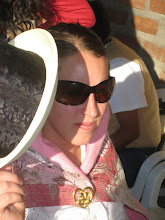Reminiscent of an aging highway in the states, the old Pan-American feels a bit used, a bit dusty. Pacora, the closest town to my community, is cut by it, as are all of the towns out in my direction. Once the major road between Piura and Chiclayo, but no longer, it is still highly trafficked. As opposed to a highway in the States, personal vehicles contribute to a small amount of the traffic. The cars you’ll encounter on the Pan-American are primarily dedicated to public transport and to the transport of goods.
In the category of public transport you’ll see moto-taxis, estations (station wagon taxis), ticos (random sketchy car taxis), combis (van taxis), and double-decker tourist buses. Of those, the scariest to watch are probably the tourist buses. They kind of wobble down the road at high speeds, tilting from side to side. The most dangerous to ride in are probably the combis. I’ve yet to meet a combi driver whose driving skills I completely trust. And I’ve never been in a combi with seatbelts for anyone but the driver and one of the front seat passengers. Sometimes the seatbelt isn’t even real but they require you to wear it anyway so they won’t get in trouble with the law. I always refuse, telling them it’s their own fault if they get stopped. It’s one of the only things I ever get into arguments about. They always give in.
More entertaining are the vehicles used for the movement of goods. These range from donkey carts to semis. However, the most colorful are what I refer to as mango trucks because during mango season their primary task is to transport mangos from field to market. These are like no small-semi you’ve ever seen. They are always painted in obnoxiously bright colors and on the back they usually are adorned with a larger-than-life religious image, often an agonized and dying Jesus. One of my goals while in Perú is to capture a picture of one of these mango trucks that is transporting corn. For some reason, when they load them with corn they just go crazy and they don’t stop loading until the corn is piled to a height nearly double that of the truck and protruding from the back.
Rules of the road? At first glance, it appears that there really aren’t any. And when it comes to obeying the official laws I’d say that first glance is accurate. I have personally witnessed the hand-signal language of combi drivers which is used to alert fellow divers to temporarily obey the law when cops are present. That probably has something do with the alarming number or crosses and little chapels dotting the side of the road commemorating people who have died in accidents. Otherwise it is just controlled chaos. While the Pan-American appears to be only a two lane road, it can at times have up to four lanes. Passing is not reserved for when no one is approaching in the other lane. Rather, it is expected that on-coming traffic will take note and move on over to the shoulder.
Thursday, September 25, 2008
Subscribe to:
Post Comments (Atom)

No comments:
Post a Comment